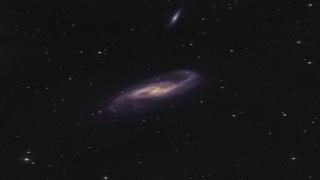Bibcode
Kim, Taehyun; Sheth, Kartik; Hinz, Joannah L.; Lee, Myung Gyoon; Zaritsky, Dennis; Gadotti, Dimitri A.; Knapen, J. H.; Schinnerer, Eva; Ho, Luis C.; Laurikainen, Eija; Salo, Heikki; Athanassoula, E.; Bosma, Albert; de Swardt, Bonita; Muñoz-Mateos, Juan-Carlos; Madore, Barry F.; Comerón, Sébastien; Regan, Michael W.; Menéndez-Delmestre, Karín; Gil de Paz, Armando; Seibert, Mark; Laine, Jarkko; Erroz-Ferrer, S.; Mizusawa, Trisha
Referencia bibliográfica
The Astrophysical Journal, Volume 753, Issue 1, article id. 43 (2012).
Fecha de publicación:
7
2012
Revista
Número de citas
39
Número de citas referidas
37
Descripción
Tidal debris around galaxies can yield important clues on their
evolution. We have identified tidal debris in 11 early-type galaxies (T
<= 0) from a sample of 65 early types drawn from the Spitzer Survey
of Stellar Structure in Galaxies (S4G). The tidal debris
includes features such as shells, ripples, and tidal tails. A variety of
techniques, including two-dimensional decomposition of galactic
structures, were used to quantify the residual tidal features. The tidal
debris contributes ~3%-10% to the total 3.6 μm luminosity of the host
galaxy. Structural parameters of the galaxies were estimated using
two-dimensional profile fitting. We investigate the locations of
galaxies with tidal debris in the fundamental plane and Kormendy
relation. We find that galaxies with tidal debris lie within the scatter
of early-type galaxies without tidal features. Assuming that the tidal
debris is indicative of recent gravitational interaction or merger, this
suggests that these galaxies have either undergone minor merging events
so that the overall structural properties of the galaxies are not
significantly altered, or they have undergone a major merging events but
already have experienced sufficient relaxation and phase mixing so that
their structural properties become similar to those of the
non-interacting early-type galaxies.
Proyectos relacionados

Las Galaxias Espirales: Evolución y Consecuencias
Nuestro grupo pequeño esta bien conocido y respetado internacionalmente por nuestro trabajo inovativo e importante en varios aspectos de la estructura y la evolución de las galaxias espirales cercanas. Usamos principalmente observaciones en varias longitudes de onda, explotando las sinergías que nos permiten responder a las cuestiones más
Johan Hendrik
Knapen Koelstra